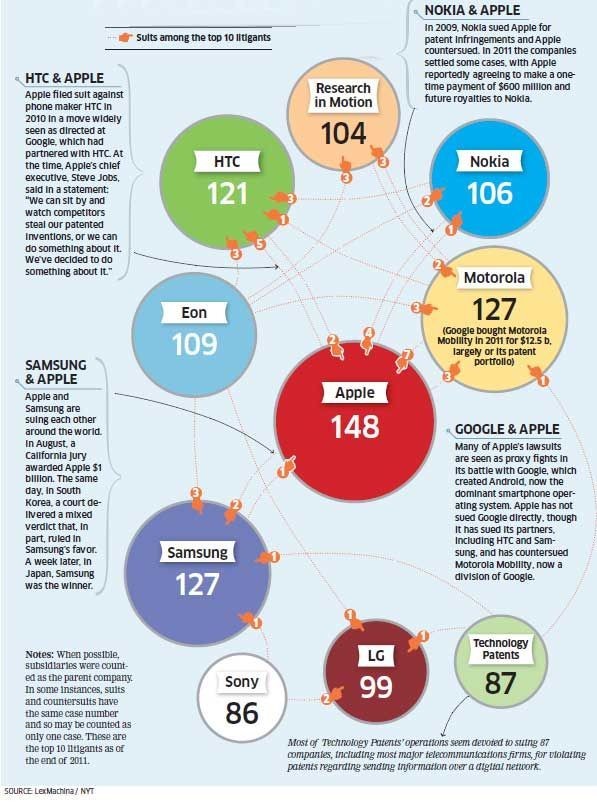Dear Professionals,
I have made an Executive Summary for my boss on Apple v/s Samsung patent verdict, passed by United States District Court, Northern District of California, San Jose Division, on August 24, 2012. I would like to share this summary with you all. For your reference, I have also attached the original verdict with this post. I hope that my contribution will be helpful to you all in updating the legal happenings in the International scenario.
Warm Regards,
Veeral Gandhi
An Executive Summary
|
Judgement of : |
United States District Court, Northern District of California, San Jose Division
|
||||||||||||||||
|
Citation : |
Apple Inc. v. Samsung Electronics Co. Ltd., 11- cv-01846, U.S. District Court, Northern District of California (San Jose).
|
||||||||||||||||
|
Suit regarding : |
Patent Infringement under the US Patent Act. |
||||||||||||||||
|
Date of Verdict : |
August 24, 2012 |
||||||||||||||||
|
Type of Verdict : |
It was a Jury verdict, with nine Jury members. |
||||||||||||||||
|
Meaning of a Jury Verdict : |
As opposed to a verdict by a qualified Judge, Jury in American parlance means, a group of men and women, who are gathered for the purpose of listening to the evidence and then deciding what is truth. They are men and women taken from everyday life, generally unfamiliar with courtroom procedure and courtroom language. The jury system in US, has been criticized by the allegation that it does not apply the law but is swayed by the emotional appeal of the particular case. |
||||||||||||||||
|
Jury members in the case and their profile : |
The presiding Juror, Mr. Velvin Hogan, is a 67-year-old electrical engineer. Among the other seven jurors were a homemaker, a bicycle shop manager and a U.S. Navy veteran. The youngest juror, a 24-year-old whose favorite Court attire is T-shirts bearing names of rock bands. Interestingly, these highly complex disputes are being decided in US by Juries, rather than Judges, and the Juries tend to issue more generous awards for patent violations. |
||||||||||||||||
|
Main Issue Involved : |
Samsung copied the look and feel of the iPhone and the iPad, patented by Apple Inc. Later sued it for infringing it’s Patent rights. |
||||||||||||||||
|
Facts of the case : |
|
||||||||||||||||
|
The Verdict : |
The jury rejected Samsung’s claim that some of Apple’s patents should be declared invalid. The jury also rejected Samsung’s counterclaims, declaring that Apple did not infringe on Samsung’s patents with the iPhone and the iPod Touch. The jury concluded that Samsung had violated a number of Apple’s patents covering things such as :
The jury validated almost all of Apple’s claims against Samsung, for many different smartphones and tablets, putting the South Korean electronics giant on the hook for $1.049 billion. The jury also found that at least some of the infringement was “willful,” which helped lead to the high figure.
|
||||||||||||||||
|
Implications on Apple : |
For a start, it will encourage Apple to file even more lawsuits. |
||||||||||||||||
|
Implications on Samsung : |
Samsung is much more than a phone maker, but it’s smartphone business has been a growth juggernaut in recent years as it’s Galaxy line has emerged as the flagship brand for Android phones and the i-phone’s one legitimate challenges in the smart phone was if Apple’s patents are finally held to be valid by the US Supreme Court, Samsung could be forced to redesign it’s phones and their user interfaces. It has found a recipe for success in the Galaxy line but now it may have to change up the ingredients. Ranjit Yadav, India head for Samsung mobile & IT, said that the company would neither slow down roll out of Samsung products here nor cut any features from its phones. |
||||||||||||||||
|
Implications on other IT companies : |
It will also encourage other companies that make smartphones and tablets either to license patents from Apple or to modify the design of products to minimise the risk otherwise, they will be hit with lawsuits too. |
||||||||||||||||
|
Implications on consumers : |
The “verdict should not be viewed as a win for Apple, but as a loss for the American consumer,” Samsung said. “It is unfortunate that patent law can be manipulated to give one company a monopoly over rectangles with rounded corners, or technology that is being improved every day by Samsung and other companies.”
|
||||||||||||||||
|
Future moves : |
Samsung has vowed to fight the case all the way to the U.S. Supreme Court. It will first ask the trial judge to toss the verdict. Failing that, Samsung will appeal to the Court of Appeals for the Federal Circuit in Washington D.C., a specialized court that hears nearly all patent appeals.
|
Attached File : 698334 1069338 verdict form of apple v samsung.pdf downloaded: 140 times



 CAclubindia
CAclubindia
